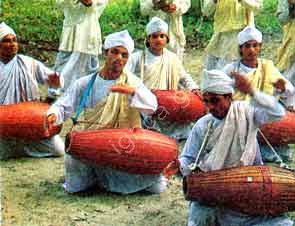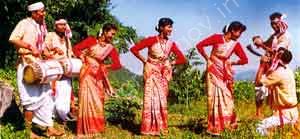Janapada Sampada
Introduction – Assam

Assam is the gateway to the north-east, a state known for its breath taking scenic beauty, rarest flora and fauna, lofty green hills, vast rolling plain, mighty waterways and a land of fairs and festivals. Known in the ancient lore as the kingdom of Pragjyotisha and Kamrupa, the capital having been Pragjyotishpura situated in or near Guwahati. It originally included in addition to modern Assam, parts of modern Bengal and modern Bangladesh. The name Assam is of recent origin. It came into use after the conquest of Assam by the Ahoms. It is also known that “Assam” is derived from the word “Asama” meaning uneven. Assam is almost separated from central India by Bangladesh. Nagaland, Manipur and Myanmar bound it in the east, west by West Bengal, north by Bhutan and Arunachal Pradesh and south by Meghalaya, Bangladesh, Tripura and Mizoram. It is dominated by the mighty Brahmaputra, one of the great rivers of the world (length: 2900 kms), which not only has a fertile alluvial plain for growing rice, but also is famous for tea. Earthquakes are common.
The Ahoms, a Buddhist Tai tribe, under Sukapha arrived in 1228 A.D., deposed the ruler and established the kingdom of “Assam” with its capital in Sibsagar. The advent of the Ahoms changed the course of Assam’s history. They later intermixed with immigrant Bengalis and most converted to Hinduism. The Mughals attempted to invade without success, but the Burmese finally invaded Assam at the end of the 18th century and held it continuously until it was ceded to the East India Company at the close of the First Burmese War in 1826. The British administered it in name until 1947. Geographically Assam is a shadow of its former self. It has been reduced to one-third of its original size in 30 years. On the partition of India lamost the whole of Sylhet was merged with East Bengal(present Bangladesh). Dewanagiri in North Kamrup was ceded to Bhutan in 1951. In 1948, the N.E.F.A. was separated from Assam. In 1963 Nagaland was carved out of Assam as a full fledged state. On 21st January, 1972 Meghalaya was cut out of Assam as a separate state and Mizoram became a Union Territory. In 1987, Mizoram was granted statehood. Nature has ungrudgingly blessed Assam with an abundance of scenic grandeur, a wealth of rare and near-extinct wildlife.
It forms part of a global bio-diversity “hotspot”, out of 41 listed endangered species of wildlife are found in Assam, which includes Golden Langur, Hoolock Gibbon, Pygmy Hog, Hispid Hare, White-Winged Woodduck, Tiger, Clouded Leopard, Swamp Deer, Gangetic Dolphins, etc. Moreover, during season, flock of resident and migratory birds make Assam their natural habitat. Rainfall, one of the highest in the world (between 178 and 305 cms), is concentrated in 4 months, June to September. Straddling either banks of the Brahmaputra, Guwahati-said to be the legendary Pragjyotishpur or City of Eastern Light was said to have been founded by King Narakasur, who is mentioned in the Puranas and Epics. is a bustling, busy and crowded city. It is the commercial capital of the North-East. Guwahati are actually two words: Guwa meaning areca nut and Hat meaning market or market for areca nuts.

The ethnic origin of the Assamese varies from Mongoloid tribes to those of directly Indian stock. The earliest inhabitants of Assam were probably of Austric stock. They are termed as “ proto- Austroloid”, because they are said to have migrated from the Australian and some other islands of the Pacific Ocean to the Asiatic mainland. The Khasis and Jaintias appear to be descendents of the proto-Austroloids of ancient Assam. After the Austrics, the Mongoloids had entered into Assam. Among the Mongoloids, the Bodo tribe appeared and established over the valley of Brahmaputra early. The Kacharis also known as the Bodos were once very powerful people. At a time, they are known to have ruled over the whole of Assam. The other branches of this tribe are- Kacharis, Meches, Garos, Abors, Miris, Mishmis, Rabha, Tipra, Akas, Daflas, Nagas, Kukis, Mikirs and Mizos.
On the eve of the coming of Ahoms in the 13th century, the Kacharis and Chutias were ruling over a large part of eastern Assam. Next came the Aryans who settled in the Brahmaputra valley at an early time. Of course, among different races, the Aryans could establish their cultural supremacy over this country.
Broadly, the inhabitants of Assam can be divided into three categories, namely the tribal population, the non-tribal population and the scheduled castes. The Tribals consist of different ethno-cultural groups such as the Kacharis (Bodos), the Miris, the Deoris, the Rabhas, the Nagas, the Garos, the Khasis,etc. The non-tribal groups include Ahoms, the Kayasthas, the Kalitas, the Morans, the Muttaks, the Chutias, etc. The scheduled castes includes the Basfors, Baniyas, the Dhobis, the Hiras, the Kaibartas and the Namasudras, etc. The immigration was mostly from Bengal, Bangladesh, Bihar, Uttar Pradesh, Nepal and Rajasthan. Another group was known as “Baganias” who were brought from Bengal, Bihar, Orissa, and Madhya Pradesh by the British tea planters during the British period for employment. Some of the early settlers of Assam were of Aryan and Dravidian stock. The original inhabitants were known as the Kiratas of divergent tribal groups as mentioned in the Mahabharata. The fusion of divergent cultures of the Aryan, the Dravidians, the Austrics and the Mongoloid races take shape into composite culture.
There is a gradual development of liberalism in religious system in Assam. The indigenous groups are Aninmism, Tantricism, Brahminism and Vaishnavism. The Assamese were practising Tantric forms of rituals until the advent of the new Vaishnavite religion formed by Shrimanta Sankardeva (1449-1568). The pristine form of Hinduism began only when the Aryans arrived in Assam.

The present Hindu caste system had emerged with the immigration of outsiders. Neo Vaishnavism entered the land in the 15th century and is the dominant faith if the Assamese people at present. The Assamese society is an open society based on the principles of liberalism. It allows the idol worshippers of Durga, Kali, Saraswati, and others to follow the Vaishnava faith. The Muslims started coming in the 13th century and established mosques in Assam. Christianity began to grow in the state from the time of the British rule and spread out to all corners of the eastern regions quickly. Caste system has never taken firm roots in the Assamese social stratification.
Assam is a land of fairs and festivals. Most of the festivals celebrated in Assam have their roots in the diverse faith and belief of her inhabitants. They reflect the true spirit, tradition and life style of the people of Assam. The culture of Assam is a rich tapestry woven with multicolour yarns of distinct heritage of all the races that inhabit there. The predominant language is Assamese.
About 63% of the state’s working force is engaged in agriculture and allied activities. More than 79% of the total cropped area is utilized for food crops production. Rice is the principal food crop. Jute, tea, cotton, oilseeds, sugarcane, potato and fruits are the main cash crops. Forest account for 22.41% of the total area of the state. Assam’s tea gardens produce just over half of the country’s tea and contributes about one sixth of the world’s entire tea production. Assam holds a unique position in respect to mineral oil production. Coal, limestone, refractory clay, dolomite and natural gas are the other minerals found in the state. Extensive oil reserves were found in the 19th century and Digboi became the site of Asia’s first oil refinery.

Assam has three oil refineries at Digboi, Noonmati and Bongaigaon and the fourth one is a petro-chemical complex at Numaligarh .A substantial part of the country’s total petroleum output and natural gas is found in the state. The forests continue to provide essential timber, resins and tanning material from tree bark while bamboo is used for paper making. Besides a public sector fertilizer factory at Namrup, the industries located in the state are sugar, jute, silk, paper, plywood manufacture, rice and oil milling.
A polyester spinning mill has also been established at Nathkuchi village of Kamrup district. The major power stations are: Chandrapur Thermal Project, Namrup Thermal Project, Karbi-Langpi-Hydel Electric Project and Lakwa Thermal Power Station. Assam is the largest producer in the world of the golden coloured “Muga Silk”.

The major festivals celebrated in assam are Bihu-Bhogali or Magh Bihu (January), Rongali or Bohag Bihu (April), and Kongali or Kati Bihu (May) celebrated by people irrespective of caste, creed and religion throughout Assam. Other festivals are- Baishagu (celebrated by Bodo Kacharis during mid April), Ali-Ai-Ligang (festival of the Mishing tribe, February-March), Baikho (Rabha tribe, spring season),Rongker (important festival of the Karbis, April), Rajini Gabra and Harni Gabra (Dimasa tribe), Bohaggiyo Bishu (spring festival of the Deoris), Ambubashi Mela (most important festival of the Kamakhya Temple is celebrated during mid June every year. It is a ritual of austerities celebrated with “tantric” rites) and Jonbill Mela (spectacular fair held every year during winter at Jonbeel of Jagiroad, near Guwahati) and so on.
However, the people of assam also celebrate Janmastmi (August), Durga Puja (October), Diwali, Idd, Muharram, Me-Dam-Me-Phi, the birth and death anniversaries of the Vaishnavite saints Shrimanta Sankardev and Shri Madhabdev.

WILDLIFE SANCTUARIES
1. Kaziranga National Park: Kaziranga, the world-renowned park lies in Golaghat and Nagaon district. It covers an area of 430 sq kms. It is the home of the great Indian one- horned rhino, breeding place of pelican.
2. Manas National Park: The only Tiger Reserve of Assam. Manas is one of the most magnificent National Parks of India. It is also a world heritage site.
3. Nameri National Park (on the border of Arunachal and Assam).
4. Dibru-Saikhowa National Park.
5. Orang (Rajiv Gandhi) National Park.
6. Pabitora Wildlife Sanctuary
7. Bura-Chapori Wildlife Sanctuary
8. Laokhowa Wildlife Sanctuary
9. Chakrasila Wildlife Sanctuary, Dhubri. 10. Bornadi Wildlife Sanctuary, Darrang.
11. Garampani Wildlife Sanctuary, Golaghat. 12. Pani Dihing Bird Sanctuary, Sivasagar.
13. Bordoibam Bilmukh Sanctuary, Lakhimpur, Dhemaji. 14. Deepor Beel Bird Sanctuary, Guwahati.
Guwahati (gateway to the Assam and N.E. region & principal city of Assam.). Kamakhya & Bhubhaneshwari temples; Basistha Ashram; Navagraha Temple; State Zoo; Museum; Regional Science Centre; Planetorium; Tirupati Balaji Mandir; Srimanta Sankardev Kalakshetra; Umananda Temple; Shree Shyam Mandir, etc. Dispur (capital of Assam); Diphu (centre of Karbi art and culture).
Sibsagar (seat of Ahom rule in Assam- Shivdol, Vishnudol, Devidol, Rang Ghar, Talatol Ghar, Joysagar, Ahom Museum, Gargaon, Kareng Ghar, Charaideo, etc.); Sualkuchi (famous for Assamese silk-Muga& Pat); Chandubi (a natural lagoon and picnic spot); Barpeta (Vaishnava Monastery, Shrine of Shri Madhab Dev).
Hajo (where three religions meet- Hinduism, Buddhism & Pao-Mecca, a mosque for Islam); Jorhat and Dibrugarh (major tea producing areas); Tezpur (temples, ancient ruins and monuments-Da Parbatia, Agnigarh, Bamuni Hills, Bhairavi and Mahabhairava temples and the twin tanks of Bar Pukhuri and Padum Pukhuri and Cole Park).
Madan Kamdeva (famous for erotic sculpture of 12th century); Sri Surya Pahar(rock- cut images); Digboi ( one of the world’s oldest oil refinery); Majuli (largest river island of the world, centre of Vaishnava culture. There are many satras, which are regarded as the main centres for Assamese art, music, dance, drama, etc.); Jatinga (famous for the bird mystery near Haflong), Haflong (only hill station in Assam); Bhalukpong (famous for scenic beauty, picnic and angling spot); Bhairavakunda (a picnic spot at the border of Arunachal Pradesh, Assam and Bhutan); Daranga (famous winter mela held every year); Bordoa (birth place of Shri Sankardev, famous Vaishnavite reformer of Assam).




